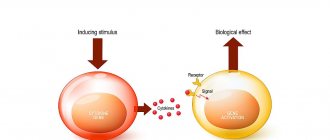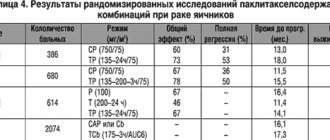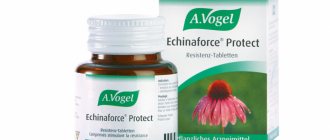Composition and release form
Ingaron contains both the main component and excipients. Interferon gamma is used as the active ingredient. Additionally, the drug contains mannitol.
The drug externally is a porous, loose, hygroscopic mass. The drug is white in color and is available in the form of a lyophilisate, which is used to prepare nasal drops.
When purchasing a medicine, the kit includes 1 bottle of Ingaron, 1 ampoule with 5 milliliters of solvent and 1 dropper cap or pipette for preparing an intranasal solution. The manufacturer also includes detailed instructions for use in the box.
Help your immune system. Why does the body need interferon after vaccination?
During the period of vaccination against COVID-19, many people have different questions: “How will my body tolerate the vaccine? Is there a risk of getting ARVI? How to protect yourself from coronavirus between doses of the two components of the vaccine? We talked about drugs that help not only fight the virus, but also strengthen the immune system, with Alexander Karaulov, Doctor of Medical Sciences, Academician of the Russian Academy of Sciences, Head of the Department of Clinical Immunology and Allergology, Head of the Laboratory of Immunopathology of the First Moscow State Medical University. I. M. Sechenov.”
— Alexander Viktorovich, how does the body react to the introduction of the vaccine?
- In fact, with the help of a vaccine, we train our immune system for a future meeting with the pathogen. Scientists emphasize that approximately 3% of the population suffers from COVID-19 severely, and 0.3% may have a life-threatening course of the disease. Moreover, if earlier we saw that severe cases were more common among the elderly and patients with concomitant diseases, now the majority of life-threatening conditions occur in patients aged 40 to 60 years. Only 50% of those who have had COVID-19 have developed antibodies.
Vaccination protects against infection, and if it does occur, the infection is mild. However, post-vaccination immunity is formed differently in different groups of people. Its formation can be slowed down in older people or patients with weak immunity, that is, in those whose body’s defenses are weakened by past or concomitant infections, chronic diseases, stress, malnutrition, environmental conditions, etc.
— Nowadays there is a lot of talk about interferons, that they strengthen the immune system. Many studies have already been published on the use of drugs of this group for COVID-19; in Russia they have become part of the standards of medical care. How do interferons work during vaccination?
— Interferons in our body perform a regulatory function. To put it figuratively, interferon is a traffic controller at a crossroads: it directs the immune response in the right direction, thus promoting recovery. This property of interferon is also excellent for preparing for vaccination, which, in essence, is also the body’s immune reaction, but not for the purpose of recovery, but for the purpose of more effectively producing antibodies against the causative agent of the disease.
— How exactly does interferon affect the level of antibody production?
— Interferons promote the activation of the immune system, enhance the production and maturation of cells that trigger the formation of a high-quality immune response. Interferon-based drugs can be used before vaccination, several hours later, or the next day after the vaccine is administered. You just need to understand that they do not act instantly: this is a process that will take some time. Taking into account the accumulated clinical experience, I would recommend, for example, a rectal form of interferon for five days before vaccination or five days after. This can enhance the formation of an immune response and prevent the patient from contracting other diseases while an adequate level of antibodies to the vaccine has not yet been developed.
— Is it possible to get sick with ARVI or the same “corona” during vaccination?
— You can get sick because at this moment all the energy of the body is directed, as I said earlier, to the production of antibodies: immunity is not formed from the first day, this has already been voiced many times. Of course, there is a risk of getting another or the same infection for which you are vaccinated if antibodies have not yet developed. To prevent this from happening, prevention is needed. Unfortunately, people are so tired of the pandemic that, after getting their first vaccination, they often stop even wearing masks. But it is important to understand that any disease during the vaccination period is a double burden on the body. Therefore, you need to behave very responsibly during this period.
— In what cases, in addition to vaccination, can interferon drugs be used during the COVID-19 epidemic?
— First of all, as a preventative measure, use gel or ointment with interferon, which are applied to the nasal mucosa. In fact, this is a universal means of preventing ARVI, the effectiveness of which was proven even before the coronavirus pandemic, during the annual flu epidemics. Gel bases have a prolonged (long-lasting) preventive effect and are convenient to apply.
— Is it possible to treat COVID-19 with interferon drugs?
— As for treatment, I cannot help but draw attention to the importance of using the rectal form of interferon: suppositories. In this case, the body, weakened by the disease, receives the missing interferon necessary for an adequate response to the infection, additionally in the drug. Suppositories have a systemic effect on the body as a whole, that is, interferon administered rectally can penetrate all organs and tissues affected by the virus. Today we are faced with a huge number of neurodegenerative complications of COVID-19. The virus easily penetrates the organs of the central nervous system, sometimes causing irreversible changes in them. Thanks to rectal administration, interferon, using the lymphatic pathways, is able to penetrate into the cerebrospinal fluid, preventing the development of dangerous complications. It is also quickly delivered to the lungs - it is not without reason that it has been used for many years in the treatment of pneumonia.
Research on the use of interferon for coronavirus is actively underway in the West and in Russia. We receive new data almost monthly. For example, our colleagues from Omsk Medical University conducted a study involving 140 patients with COVID-19. 70 of them received standard therapy, and another 70 combined it with VIFERON rectal suppositories and gel, both of which were used regularly for 14 days. According to the results of the study, the symptoms of intoxication in such patients - headache, muscle pain, weakness - stopped 2-8 days earlier. The cough disappeared by the 5th day from the start of treatment, a runny nose was recorded only for 3 days, patients stopped noticing disturbances in taste and smell by the fourth day from the start of treatment, shortness of breath stopped by the third day. In patients who did not receive additional interferon, all symptoms of the disease lasted statistically longer.
I note that in the initial stages of the disease the rule “the sooner, the better” really works. Early initiation of interferon therapy reduces the mortality rate and demonstrates better treatment results. This was confirmed by studies of our Chinese colleagues, who showed that if the initial level of interferon alpha increases, for example, due to therapy, then, as a rule, we will have a favorable outcome of the disease.
Link to publication: sigma-z.ru
pharmachologic effect
The drug Ingaron belongs to the group of immunostimulants. The main substance, interferon gamma, is a compound of 144 amino acid residues. It is obtained by microbiological synthesis in a recombinant strain of Escherichia coli and purification using column chromatography.
Interferon gamma is a cytokine that has a pronounced anti-inflammatory effect. It is produced naturally in the body by killer cells, T-helper cells, CD4 and CD8 lymphocytes.
Due to the presence of specific receptors on the membranes, cytotoxic T-lymphocytes, neutrophils, macrophages and killer cells are sensitive to this component of Ingaron. Interferon gamma activates their effector functions, including increasing microbicidal activity, stimulating the production of superoxide radicals and cytokines. these substances lead to the death of viral particles. In addition, Ingaron blocks the synthesis of proteins, DNA and RNA of microorganisms.
Interferon gamma inhibits the response of B lymphocytes to interleukin-4, inhibits the production of immunoglobulin E and the expression of the CD23 antigen. It also induces apoptosis of differentiated B cells, from which autoreactive clones can be formed that damage the body's own cells.
Interferon gamma neutralizes the suppressive effect of IL-4 on IL-2-dependent generation and proliferation of killer cells activated by lymphokines. Stimulates the synthesis of acute-phase proteins formed in response to the development of the inflammatory process in the human body. The drug is also able to increase the efficiency of antigen presentation and the ability of T lymphocytes to recognize pathogenic agents.
Ingaron lyophilisate for the preparation of solution for intranases injected 100 thousand IU + water for intranases 5 ml
Release form
Lyophilisate for preparing a solution for intranasal administration.
pharmachologic effect
Pharmacotherapeutic group
Immunomodulatory agent.
ATX code [LO3AB03]
Pharmacological properties
INGARON® is a recombinant human interferon gamma, consisting of 144 amino acid residues (a.a.), lacking the first three a. O. Cys-Tyr-Cys replaced by Met. Molecular weight 16.9 kDa. Obtained by microbiological synthesis in a recombinant strain of Escherichia coli and purified by column chromatography. The specific antiviral activity on cells (human fibroblasts) infected with the vesicular stomatitis virus is 2·107 IU per mg of protein. Interferon gamma (immune interferon) is the most important anti-inflammatory cytokine, the producers of which in the human body are natural killer cells, CD4Th1 cells and CD8 cytotoxic suppressor cells.
Receptors for interferon gamma are found in macrophages, neutrophils, natural killer cells, and cytotoxic T lymphocytes. Activates the effector functions of these cells, in particular their microbicidality, cytotoxicity, their production of cytokines, superoxide and nitrooxide radicals (thereby causing the death of intracellular parasites). Interferon gamma blocks the replication of viral DNA and RNA, the synthesis of viral proteins and the assembly of mature viral particles. At the same time, it causes a cytotoxic effect on virus-infected cells.
Inhibits the B-cell response to interleukin-4, suppresses the production of IgE and the expression of the CD23 antigen. It is an inducer of apoptosis of differentiated B cells, giving rise to autoreactive clones. It reverses the suppressive effect of interleukin-4 on interleukin-2-dependent proliferation and generation of lymphokine-activated killer cells. Activates the production of proteins of the acute phase of inflammation, enhances the expression of genes C2 and C4 components of the complement system.
Unlike other interferons, it increases the expression of MHC antigens of both classes I and II on different cells, and induces the expression of these molecules even on those cells that do not constitutively express them. This increases the efficiency of antigen presentation and the ability of T lymphocytes to recognize them.
Interferon gamma blocks the synthesis of β-TGF, which is responsible for the development of fibrosis of the lungs and liver.
Indications
Prevention and treatment (as part of complex therapy) of influenza. Prevention and treatment (as part of complex therapy) of H5N1 and H1N1 influenza.
Contraindications
Individual intolerance to interferon gamma or any other component of the drug. Pregnancy. Children's age (under 7 years).
Use during pregnancy and breastfeeding
Contraindicated during pregnancy.
Compound
Active substances:
Interferon gamma –100,000 IU (5.5±0.5).
Excipients: mannitol
Description
The drug is a loose or porous mass of white color, hygroscopic.
Directions for use and doses
Intranasally. The contents of the bottle are dissolved in 5 ml of water for injection.
At the first signs of influenza, ARVI, 2 drops in each nasal passage after toileting the nasal passages 5 times a day for 5 - 7 days.
For the prevention of acute respiratory viral infections and influenza in case of contact with a patient and/or hypothermia
2 – 3 drops in each nasal passage every other day 30 minutes before breakfast for 10 days.
If necessary, preventive courses are repeated. For single contact, one instillation is sufficient.
After instillation, it is recommended to massage the wings of the nose with your fingers for several minutes to evenly distribute the drug in the nasal cavity.
Side effects
Not noted.
Storage conditions
In a dry place, protected from light and out of reach of children, at a temperature not exceeding +25o C.
Store the drug solution for no more than 10 days in the refrigerator (do not freeze).
Best before date
2 years.
Conditions for dispensing from pharmacies
Dispensed with a doctor's prescription
Indications and contraindications for use
Ingaron in the form of intranasal drops is indicated for use in the following cases:
- Treatment and prevention of acute respiratory viral infections.
- Treatment and prevention of influenza strains H5N1 and H1N1.
It should be noted that the drug should be used as part of complex therapy for the disease.
Contraindications to the use of Ingaron:
- The presence of increased hypersensitivity to interferon gamma or to auxiliary components (mannitol) of the drug.
- The period of pregnancy and breastfeeding.
- Children's age up to 7 years.
INGARON (intranasal form)
INGARON® (interferon gamma, 100,000 IU)
human recombinant interferon gamma (immune interferon) has an immunostimulating and antiviral effect: it contributes to the formation of cell resistance to the effects of viruses.
Ingaron - effectively stimulates the immune system and provides reliable protection against influenza, including H5N1 and H1N1 influenza
.
The drug is administered intranasally (nasal drops)
- The only interferon gamma drug in the Russian Federation
- Included in the list of vital and essential drugs
- Included in the standards of specialized medical care for influenza of moderate and severe severity, severe acute respiratory viral infections, clinical guidelines for influenza and acute respiratory viral infections
- Active against a wide range of viral infections
- Potentiates the activity of many antiviral drugs used in the complex therapy of ARVI and influenza
- Drug resistance to INGARON® does not develop
- The only interferon gamma drug in the Russian Federation1
- Included in the list of vital and essential drugs 2
- Included in the standards of specialized medical care for influenza of moderate3 and severe4 severity, ARVI of severe severity5, clinical guidelines for influenza and ARVI
- Active against a wide range of viral infections 6
- Potentiates the activity of many antiviral drugs used in the complex therapy of ARVI and influenza 7
- Drug resistance to INGARON® does not develop8
1 According to https://grls.rosminzdrav.ru as of July 20, 2015 2 Appendix No. 1 to the order of the Government of the Russian Federation dated December 30, 2014 No. 2782-r 3 Appendix to the order of the Ministry of Health of the Russian Federation dated November 9, 2012 No. 724 4 Appendix to the order of the Ministry of Health of the Russian Federation dated November 9, 2012 No. 842n 5 Appendix to the order of the Ministry of Health of the Russian Federation dated November 7, 2012 No. 657n 6 Kisilev O.I., Ershov F.I., Deeva E.G. . Interferon-gamma: a new cytokine in clinical practice. Ingaron®. Moscow – St. Petersburg, 2007, p. 51-52. 7 In vitro study of the virus-inhibitory activity of antiviral drugs against influenza virus A/California/07/09 (H1N1), Influenza Research Institute of the Northwestern Branch of the Russian Academy of Medical Sciences, St. Petersburg, 2009. 8 Report on the results of a randomized, placebo-controlled study assessing the effectiveness and tolerability of the drug INGARON® (interferon gamma human recombinant)
Ingaron: instructions for use
The drug is intended for intranasal use.
To prepare the medicinal solution, the lyophilisate is dissolved in 5 milliliters of the solvent contained in the kit (water for injection).
At the first manifestations of the development of influenza or other acute respiratory viral infection, it is recommended to instill 2 drops 4 to 6 times a day into each nasal opening. The course of treatment is from 5 to 7 days.
To prevent infectious viral diseases, the development of which is possible due to general hypothermia or after contact with a sick person, you should use 2 drops of the drug every other day. Preventive course – 10 days. If necessary, the specialist may prescribe reuse of the drug.
To ensure equal distribution of the drug in the nasal cavity, improve its absorption and increase efficiency, it is recommended to massage the side walls and wings of the nose with light movements immediately after instillation.
Additional Information
The shelf life of the drug is 24 months from the date of manufacture and subject to the manufacturer’s recommendations. The medicine should be stored in a dry place, out of reach of direct sunlight. Temperature – no more than 25 degrees. Children's access to the drug should also be limited.
After preparing the intranasal solution, it can be stored at a temperature of 0 to 10 degrees (in the refrigerator, without freezing) for no more than 10 days. This is explained by the fact that the drops contain no preservatives.
You can purchase the medication without a doctor's prescription, but before starting treatment you should consult a specialist.



